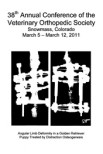Introduction: The sesamoid disease is a cause of lameness in dogs, and there is limited literature relating to diagnosis, treatment and outcome of treatment in dogs with the sesamoid disease. Our aim was to compare the efficacy of intra-articular metacarpophalangeal/metatarsophalangeal joint injection with methylprednisolone and bupivacaine (IMPB) or conservative management with nonsteroidal anti-inflammatories and rest (CMNR) for treatment of this disease.
Materials and methods: We conducted a retrospective survey of dogs treated for the sesamoid disease with IMPB or CMNR. The medical records of all dogs that received IMPB or were recommended CMNR for treatment of sesamoid pain were reviewed, and a client questionnaire was delivered to owners. Response to treatment, rapidity of response, length of resolution and recurrence of clinical signs associated with the sesamoid disease were assessed.
Results: A total of 78 dogs were included in the study. One week after IMPB, 52/58 (89.7%) dogs demonstrated resolution of lameness compared with 1 week of CMNR, 0/18 (P < 0.001). There was limited statistical evidence in client satisfaction between treatment groups, IMPB 36/53 (67.9%) and CMNR 16/17 (94%) (P = 0.052). Dogs presenting with the sesamoid disease had comorbidities in 51/78 (65.4%) of cases. Elbow disease was the most common comorbidity 29/78 (37.2%).
Conclusion: Our results support the use of IMPB for short-term (1 week) resolution of lameness associated with sesamoid disease in dogs. Dogs treated with CMNR had slower improvement; however, there was no difference in lameness or client satisfaction between treatment groups at long-term follow-up (12 months).









